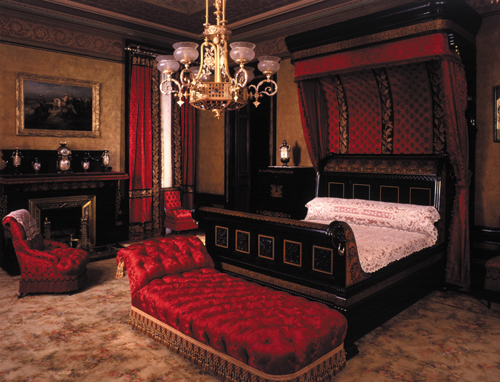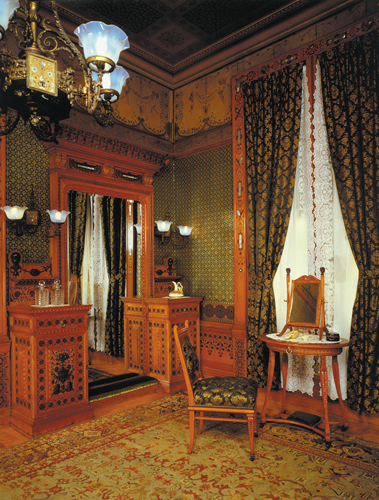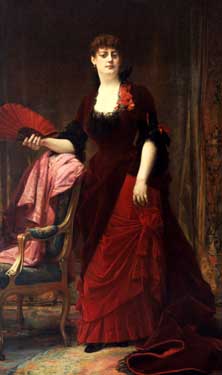
In New York in the 1880s—the gilded age when the likes of the Rockefellers, the Vanderbilts, and the Goulds were building their mansions along and near Fifth Avenue—the new aesthetic style often reigned supreme as the choice for their grand interiors. Herter Brothers, Kimbel and Cabus, Pottier and Stymus, Leon Marcotte are just a few of the firms that catered to the city’s wealthy, creating rooms in which the furniture, woodwork, textiles, and other decorative objects all bespoke a coherent whole, even if each reflected a different influence.
Last Friday two exemplary rooms from the period were given to the Virginia Museum of Fine Arts in Richmond and the Metropolitan Museum of Art—respectively, the master bedroom and the dressing room from a townhouse at 4 West Fifty-fourth Street that was redecorated in 1881 for Richmond native Arabella Duval Worsham. After she married Collis P. Huntington in 1884, she sold the house, fully furnished, to John D. Rockefeller, who evidently made few changes to the décor over the years. After his father’s death in 1937 John D. Rockefeller Jr. gave the Moorish style smoking room from the house to the Brooklyn Museum and the bedroom and dressing room to the Museum of the City of New York, which, when it became clear that they would not fit in its current renovation plans, decided to give them to institutions where they would be widely accessible. Neither room will be immediately accessible, however: at the Virginia Museum the bedroom will be installed in the new McGlothlin Wing, scheduled to open next year; the dressing room will probably not be unveiled at the Metropolitan Museum for a few years.

But this may be a good thing, as it will provide time for further investigation of these exceptional interiors. Much remains unknown about the commission, and the gift has reignited a controversy over which firm Arabella Worsham called on to redecorate her house. Alice Cooney Frelinghuysen, the Anthony W. and Lulu C. Wang Curator of American Decorative Arts at the Metropolitan, is researching the little-known firm of George A. Schastey and Company, which is one of the top contenders based on Schastey’s claim in a letter he wrote to Rockefeller in 1884 that he had done the interiors. After working for Pottier and Stymus, Schastey set up his own business on Twenty-third Street in 1873, and some sources suggest he was on West Fifty-third Street at the time he did the Worsham house.
Meanwhile, Susan J. Rawles, Assistant Curator of American Decorative Art at the Virginia Museum, has unearthed information that supports a claim made by Mitchell Samuels of French and Company in 1938 that that firm’s predecessor, Sypher and Company, had provided the bed—and by extension the coordinating bedroom. “We had an Empire bed, said to have been presented to the Princess Demidoff, niece of Napoleon I,” he wrote to Rockefeller Jr. “Mrs. Huntington saw the bed in our establishment and remarked that it was used as a model for the bed that was made for her.” Samuels went on to say that the woodwork in the house was “undoubtedly done by Pottier and Stymus as they were the premier cabinetmakers of the time,” although there is no known documentation of their involvement.

Indeed, Barry R. Harwood, Curator of Decorative Arts at the Brooklyn Museum (the smoking room is traditionally thought to be by Schastey) observes, “there is no reason to believe that all the decoration was necessarily by the same firm. It even seems likely that if a firm got too busy it might subcontract some of its work on these huge commissions.”
Except for Herter Brothers, whose work was thoroughly documented in the groundbreaking book and exhibition organized in 1994 by Frelinghuysen, Katherine Howe, and Catherine Voorsanger (and other contributors), many of the masters of the aesthetic period remain cloaked in some obscurity. The re-emergence of the Worsham-Rockefeller rooms seems the perfect catalyst to digging deeper into surviving records, photographs, catalogues, and other documents, in hopes of clarifying their output and their working methods.
